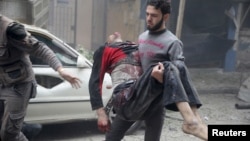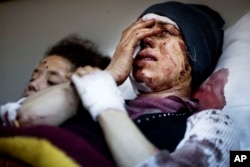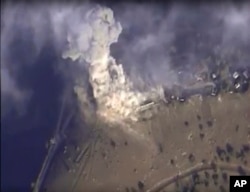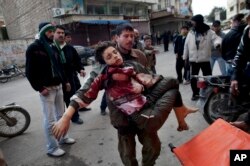As the war in Syria expands, with Russia's role growing, new ground assaults taking place in multiple areas and the United States planning new efforts to fight Islamic State militants, rights activists say civilians are increasingly falling victim. And even combat leaders say that civilians are being used as tools in the war.
Rights workers say Russian airstrikes deliberately target schools and field hospitals in rebel-held and contested areas, aping the tactics of the Syrian air force loyal to President Bashar al-Assad. Human rights groups also document cases of rebel groups using civilians a human shields to deter attacks by the Russians and pro-Assad forces. One rebel commander confirmed that practice to VOA.
Human Rights Watch accused Syrian rebel groups aligned with Jaish al-Islam, or Army of Islam, of placing civilians including women, in cages to be used as human shields to deter airstrikes in Douma outside the Syrian capital Damascus. On Friday, Douma was struck by merciless Russian and government air raids that left at least 70 people dead and 500 wounded, according to the humanitarian group Doctors Without Borders (MSF).
A few days later, Jaish al-Islam fighters rounded up about 500 members of President Assad’s Alawite sect. They are now being held in cages and moved around Douma in trucks to discourage more government airstrikes.
A senior rebel commander, who spoke on the condition of anonymity, admitted to VOA that anti-Assad insurgents increasingly have fewer qualms about exploiting civilians as human shields either as blatantly as in Douma or in more disguised ways — and that includes non-combatants on the rebels’ side.
In the northern Aleppo countryside, IS and rebel militias aligned to the Western-backed Free Syrian Army, or FSA, have been locked for months in a desperate fight for control of key towns and villages just south of the border with Turkey.
“In the villages north of Aleppo around Marea and Tal Rifat, what IS militants are trying to do is occupy civilian areas and then they defend themselves inside them so civilians are around — and we are doing the same thing,” the rebel commander said.
“This is total war,” he added.
Air war casualties
The heaviest casualties continue to come from the air. The Syrian Network for Human Rights, which documents abuses and violations by all sides in the conflict, reported Wednesday that Russian airstrikes in 36 days have “killed more civilians than the U.S.-led international coalition has killed in a year."
The group says it has documented 254 civilian deaths, including 83 children and 42 women, in Russian airstrikes since they began September 30.
“To the Russians, any military body that fights the Syrian regime is labeled as a ‘terrorist’ that must be eliminated. Russian political figures claim that their aim is to fight terrorism in Syria, embodied by IS; however, they are killing civilians and armed groups that oppose the Assad government,” the group said.
Moscow dismisses allegations its warplanes have targeted civilian facilities. Earlier this week, the Defense Ministry denied Western media reports of Russian warplanes bombing hospitals in rebel areas, saying the medical facilities named don’t actually exist.
Rights groups, medical charities and locals have accused Russia of bombing up to 10 field hospitals in rebel-held areas, including two in the southern Aleppo countryside, which is currently at the center of a ground offensive by forces loyal to President Assad.
“We investigated this information,” Major-General Igor Konashenkov, the ministry spokesman, said Monday. “It turned out, in fact, that there is a hospital only in the settlement of Sarmin. There are no hospitals in al-Ees, al-Hader, Khan Tuman, Latamna and al-Zirba, and, consequently, there are no healthcare workers."
Makeshift facilities hit
That may be the case in terms of official pre-war government hospitals, but makeshift field clinics have been set up or funded throughout the war by relief groups and charities, including the U.S.-based Syrian-American Medical Society, which supports 95 facilities in Syria and neighboring countries.
The Syrian-American Medical Society runs the hospital at Sarmin, in Idlib province, which was reportedly hit on October 20. The Russian defense ministry insists the hospital was “absolutely undamaged.” And this week it posted on social media aerial photographs of the area, purportedly taken 11 days after the attack, to buttress its claim.
But an analysis released Wednesday by Bellingcat, a citizen journalist investigative collective that scrutinizes open-source videos, maps and satellite imagery, accused the defense ministry of manipulating data.
The group says Moscow has “falsely dated aerial imagery in an attempt to disguise the destruction of the airstrikes that occurred on 20 October.” The researchers conclude that the main target of the bombing raid may not have been the clinic itself but in fact a nearby school.
They add, though,“While airstrikes may not have struck the SAMS field hospital directly, it was clearly damaged as images from the ground from locals attest.”
“Russian propagandists can claim all they like they are not striking hospitals and civilian sites but they are,” says Bassam, a local governance organizer who travels throughout the war zones across Syria. His family name is being withheld because he has relatives still in Damascus. “It is shocking the Russians are doing exactly what Assad’s air force has been doing for years — why do they fear clinics and buildings used by activists who are developing local councils?”












